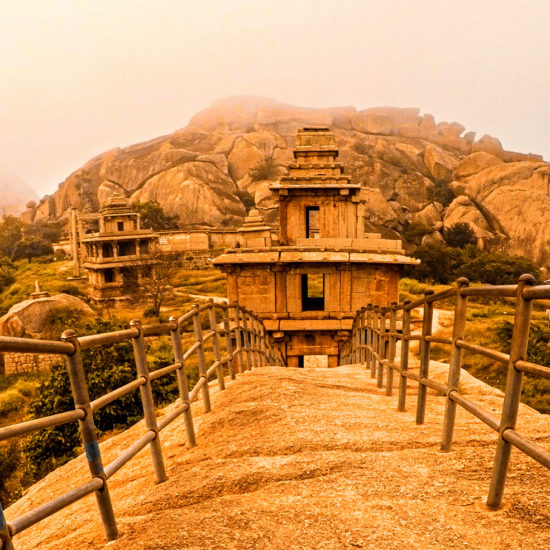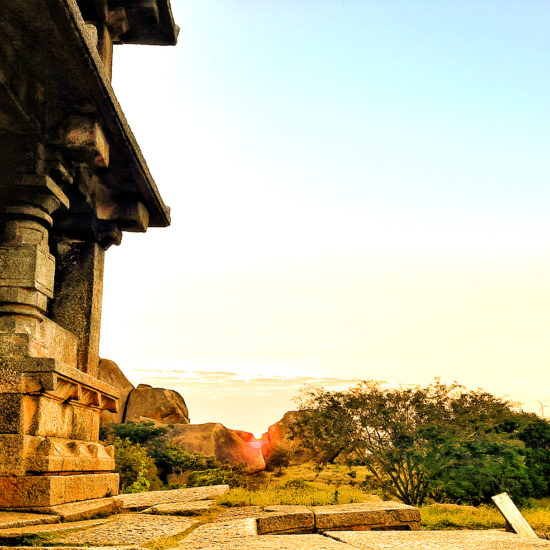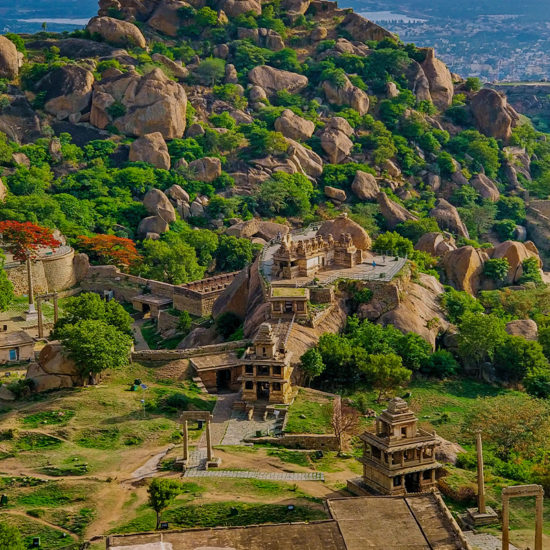Chitradurga offers visitors an irresistible mix of history, legends and spirituality. Chitradurga offers visitors a spectacular boulder-strewn landscape which has an unconquerable fort with astounding defenses, ancient temples and a history full of valour and bravery.
It is believed that the name of the place earlier was ‘Chatrakaldurg ‘, the word ‘Chatrakal’ meaning umbrella rock, being derived from a striking umbrella-shaped hill in the south-western part of the town. And according to legends, Chitradurga is where Bhima killed the demon Hidambasura and married his sister Hidimbi. Chitradurga has been part of many dynasties like the Shathavahanas, Kadambas of Banavasi, Chalukyas, Pallavas, Rastrakutas, Cholas, Vijayanagara, Paleyagaras and the Mysuru Wadiyars. Molakalmuru taluk is also home to 3 inscriptions of Ashoka’s Minor Rock Edicts. The historic discovery by B. L. Rice in 1892 confirmed that the vast empire of Emperor Ashoka included parts of modern Karnataka as well.
Geographically, Chitradurga is surrounded by Tumkuru in the south, Chikkmagaluru and Davanagere District in the west, Ballari in the north and Andhra Pradesh state in the east. It also has a rich cultural past. Chitradurga has produced writers like Madhava who penned Madhavalankara, Rangakavi of Virupaksha Shathaka, Babburu Ranga. The pioneers of modern Kannada literature like T. S. Venkanaiah, Ta. Su. Shyamaraya, novelist TaRaSu, Sitarama Sastry, Belagere Chandrashekar Shastry, Belagere Krishnashastry, Belagere Janakamma and so on have contributed to the Kannada literature through their works. A theatre for performing arts is located in the heart of the city named after the well-known novelist Talukina Ramaswamy Subbarao (TaRaSu). Recently the TaRaSu Rangamandira has been renovated and it has high-tech sound and light systems with a spacious stage, green room with a seating capacity that can accommodate over 500 people.
For further information, visit the official district website click here!
Heritage Sites
- Chitradurga Fort: Chitradurga Fort is locally known as Elusuttina Kote (meaning the fort of seven circles) and is one of the country's strongest hill forts. The fort originally had to have had 19 gateways, 38 postern-gates, 35 secret entrances and 4 'invisible' entrances. Many of these have gone out of existence now. The doors were made of strong and thick wooden beams fastened with iron plates. The soaring ramparts hewn from rock complement the craggy landscape and were designed so that each line of fortification overlooks others below. Zigzagging pathways slowed down enemy soldiers and prevented the use of battering rams. The doors of the main gateways were, in addition, bristling with iron spikes to ward off elephants.The fort has numerous temples like the Sampige Siddheshwara, Hidimbeshwara, Ekanathamma, Phalguneshvara, Gopalakrishna, Anjaneya, Subbaraya and Basava. A big piece of bone has been kept in the Hidimbeshwara Temple and is shown as the tooth of the demon Hidambasura, and a cylinder of iron plates, six feet high and ten feet in circumference, as the bheri or kettle-drum of Bhima. A figure of Hidambasura is sculptured on the Vimana. In the Siddheshwara Temple also is kept a piece of bone much larger than that kept in the Hidimbeshvara temple, which also is believed to be as the tooth of Hidambasura.A must see in this fort is the Onake Obavvana Kindi, named after a brave woman Obavva. It is connected with the famous attack of Haidar Ali on Chitradurga. Haidar's forces were unable to enter into the fort, in spite of a long siege. They soon found a small crevice through which they could get into the fort. It was a very narrow crevice, hardly admitting a human being in a kneeling position. Obavva hid herself there and saw the enemy trying to get inside. Displaying remarkable courage, she grabbed onake (a pestle) and killed each soldier getting inside.Chitradurga fort is famed for its sophisticated water harvesting system. Interconnected reservoirs collected and stored rainwater, which overflew from each tank flowing into other tanks below it. Such an effective system ensured that the fort never ran out of water. After filling all these tanks, the water used to flow to the moats round the fort-walls.
- Chandravalli:Chandravalli is situated immediately to the west of the fortified hill of Chitradurga. The archaeological discoveries made in the site, which take us to the Satavahana period and further back reveal settlements that are around 3000 years old. Lead coins belonging to the Satavahanas, Roman silver coins and ornaments of gold, silver and copper were discovered here. The hills around here are sprinkled with prehistoric caves and temples.
- Minor Rock Edicts of Ashoka, Molakalmuru: Being one of the places where Minor Rock Edicts of Ashoka have been found, this place is of great archaeological interest. The discovery by B L Rice in 1892 of three of Ashoka's inscriptions in the Molakalmuru taluk has put it beyond doubt that a major portion of the present Karnataka State, including Chitradurga was included in his dominions. Though Ashoka's edicts had been found inscribed on rocks in various parts of northern India, the farthest points in the South in which they were known to occur were at Girnar in Saurashtra. This discovery therefore revealed that the Maurya empire extended at least upto Chitradurga district. The 3 Ashoka inscriptions situated in these hills on the right and left banks of the Janagahalla (Sanna Hagari) River where it crosses the Molakalmuru taluk from west to east.The best preserved is the Brahmagiri inscription, engraved on the top of a great boulder of gneiss at the north-west of the hill of that name, at a point called Ganjigunte Mule. This boulder was well-known in that area as the Aksharada Gundu (meaning letter-rock) and was supposed to have medicinal virtues. The inscription, which is cut on the undressed horizontal surface of the rock, consists of thirteen more or less irregular lines. Brahmagiri, as these rock edicts indicated was termed as the site of Ishila, one of the provincial capitals of Ashoka's empire and denoted the southernmost extent of the Mauryan Empire. The inscription is issued from Suvarnagiri at the word Ashoka (Aryaputra) to the officers (mahamatras) stationed at Ishila. The second Ashoka inscription is quite nearby located near Siddapura on a rocky hill called Yemme Tammana Gundu. It consists of twenty-two lines and is engraved in lines of varying length on the sloping surface of the rock. The third inscription is on the western summit of the Jatinga-Rameshwara hill, about three miles north-west of Brahmagiri. The inscription is cut on a very irregular and slanting horizontal surface of rock. The floor on which the inscription is cut is immediately in front of the stairs leading up to the Jatinga Rameshwara temple. Moreover, owing to the convenient shadow of an overhanging boulder, the site of the epigraph was the favourite place of the bangle-sellers at the annual festival here. Hence the rock is called the Balegara Gundu (meaning bangle-sellers' rock). Greatly defaced, as one can see many holes punctured into the rock which were perhaps meant to hold the poles of the tents erected at these annual fairs. So far it can be made out that it consists of about twenty-eight lines. All the three inscriptions are engraved in Brahmi characters and expressed in Prakrit language. But a remarkable exception in the matter of script from other places in Karnataka is that the last word in each has been cut in Kharosthi characters/ language.
- Brahmagiri: A very ancient place with Ashokan edicts, evidence of pre-historic cultures and Trishankeshvara temple.
- Aimangala: Home to a large fort with three ruined gates and massive walls. Built during the 17th and 18th century and served as a stronghold of Hyder Ali. Virabhadra temple is another important monument in Aimangala
Religious Places
- Sirigere: Sirigere is a village situated about 15 miles northwest of Chitradurga. The place is famous for the Veerashaiva Matha of Taralabalu Sampradaya, originally said to have belonged to Ujjayini. The Matha, is renowned for its social work including running a high school and a number of hostels called Taralabalu Jagadguru hostels.
- Shiva Temple, Adumalleshwara: Located around 5 km from Chitradurga, Adumalleshwara is a cave temple dedicated to Lord Shiva and built by Aadooru Mallapa. The main attraction of this temple is the perennial stream which runs through the Nandi's (Lord Shiva's vehicle) mouth. Nearby the temple is a small zoo called Adumalleshwara Mini Zoo which is home to Leopards, Sloth Bears, Rock Pythons and a variety of birds.
- Ganesha Temple: Ganesha temple is located in Holalakere, 35 kms from Chitradurga. The 20 ft tall monolithic idol of Lord Ganesha was established here in the 15th century.
- Nayakanahatti: Nayakanahatti is a village in Chitradurga district, popular for Tipperudra Swamy temple. Tipperudra Swamy was a 15th century spiritual guru who preached principles such as ‘Kayakave Kailasa’ (work is worship).
- Jatinga Rameshwara: A hill and temple with Ashoka era inscriptions in Molakalmuru taluk. Surya, Veerabhadra and Bhogeshwara are other three small but beautiful temples. Legend has it that Jatinga Rameshwara is the spot where giant bird Jatayu, who attempted to prevent Ravana from kidnapping Seeta, was killed by Ravana through deceit. A set of footprints attributed to Sita and a dedicated temple to Jatayu can be seen.
- Teru Malleshwara Temple, Hiriyur: Hiriyur is a town situated on the right bank of the Vedavati River. The Teru Malleshwara Temple dedicated to Lord Shiva is a large structure built in the Dravidian style, with a mahadwara (big gate) surmounted by a lofty gopura. The open mukhamantapa has entrances on three sides. In front of it stands on a high pedestal a fine dipastambha (lamp-pillar) of about 45 feet high, with a pavilion at the top enshrining a Basava (Lord Shiva's vehicle) and 8 lamps in the form of huge iron cups, two in each direction. The ceilings of the mukhamantapa are painted with scenes from the Shaiva puranas. In the navaranga are kept three sets of metallic figures, large/ small images of Lord Shiva and Goddess Parvati and Uma-Maheshwara seated on Nandi. These are taken in procession in three separate cars during the car festival which takes place around January-February every year.
- Sri Gayathri Reservoir, Hiriyur: About ten miles south-west of Hiriyur, where the Suvarnamukhi River flows into the district from Tumkuru, a fine reservoir has been built across the river, called Sri Gayathri Reservoir, to irrigate about 3,000 acres. The place has a picturesque setting surrounded by low-lying hills and verdant valleys. The channels which take off from the reservoir helps in irrigation in the Hiriyur taluk.
- Ashoka Siddapura: Home to Surya, Ishwara, Veerabhadra, Bhogeshwara temples and a Jain Basadi.
Tourist Attractions
- Jogimatti Wildlife Sanctuary:Spread across 38.8 square miles in Chitradurga, Hiriyur and Holalkere taluks, Jogimatti Wildlife Sanctuary is a mesmerizing forest area with rolling hills, un-spoilt wilderness and teeming wildlife. This sanctuary plays a crucial role in protecting the diverse wildlife here. Jogimatti Sanctuary harbours Leopards, Sloth Bears, Indian Pythons, Monitor Lizards, Peacocks, Jackals, Hyenas, Jungle Cats, Porcupines, Wild Boars etc.
- Vani Vilas Dam: Karnataka's oldest dam is located around 40 km from Chitradurga near a village called Marikanive. Near this village is a large artificial lake called the Vani Vilas Sagar where a dam has been constructed across the Vedavati River which was built by the erstwhile Mysore Maharajas. The dam, which is considered a great feat of engineering skill, was commenced in 1898 and completed in 1907. Close to the reservoir is situated a shrine of Goddess Mari known as Kanive Maramma, from whom the village derives its name.
- Molakalmuru silk weaving: The weaving of pure silk cloth is a particular feature of Molakalmuru and the silk fabrics manufactured here have a good market in the district and other parts of the State. The weaving industry in the place has a wide reputation and a considerable percentage of the population of the town is engaged in it.
- Sri Gayatri Reservoir: 16 kms south-west of Hiriyur, a reservoir built across river Survarnamukhi.
Tour Location
Chitradurga is well connected by rail and road network from all over Karnataka. Chitradurga is 200 kms North of Bengaluru.







